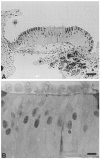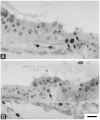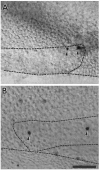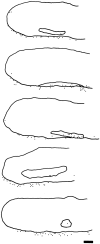Regenerative proliferation in organ cultures of the avian cochlea: identification of the initial progenitors and determination of the latency of the proliferative response
- PMID: 8757259
- PMCID: PMC6578879
- DOI: 10.1523/JNEUROSCI.16-17-05466.1996
Regenerative proliferation in organ cultures of the avian cochlea: identification of the initial progenitors and determination of the latency of the proliferative response
Abstract
Sensory hair cells in the cochleae of birds are regenerated after the death of preexisting hair cells caused by acoustic over-stimulation or administration of ototoxic drugs. Regeneration involves renewed proliferation of cells in an epithelium that is otherwise mitotically quiescent. To determine the identity of the first cells that proliferate in response to the death of hair cells and to measure the latency of this proliferative response, we have studied hair-cell regeneration in organ culture. Cochleae from hatchling chicks were placed in culture, and hair cells were killed individually by a laser microbeam. The culture medium was then replaced with a medium that contained a labeled DNA precursor. The treated cochleae were incubated in the labeling media for different time periods before being fixed and processed for the visualization of proliferating cells. The first cells to initiate DNA replication in response to the death of hair cells were supporting cells within the cochlear sensory epithelium. All of the labeled supporting cells were located within 200 microns of the hair-cell lesions. These cells first entered S-phase approximately 16 hr after the death of hair cells. The results indicate that supporting cells are the precursors of regenerated hair cells and suggest that regenerative proliferation of supporting cells is triggered by signals that act locally within the damaged epithelium.
Figures













Similar articles
-
Possible precursors of regenerated hair cells in the avian cochlea following acoustic trauma.Hear Res. 1989 Nov;42(2-3):175-94. doi: 10.1016/0378-5955(89)90143-3. Hear Res. 1989. PMID: 2606802
-
Macrophage activity in organ cultures of the avian cochlea: demonstration of a resident population and recruitment to sites of hair cell lesions.J Neurobiol. 1997 Nov 20;33(6):724-34. J Neurobiol. 1997. PMID: 9369147
-
Identification of the timing of S phase and the patterns of cell proliferation during hair cell regeneration in the chick cochlea.J Comp Neurol. 1994 Mar 1;341(1):50-67. doi: 10.1002/cne.903410106. J Comp Neurol. 1994. PMID: 8006223
-
Stem Cells and the Bird Cochlea-Where Is Everybody?Cold Spring Harb Perspect Med. 2019 Apr 1;9(4):a033183. doi: 10.1101/cshperspect.a033183. Cold Spring Harb Perspect Med. 2019. PMID: 30249599 Free PMC article. Review.
-
The challenge of hair cell regeneration.Exp Biol Med (Maywood). 2010 Apr;235(4):434-46. doi: 10.1258/ebm.2009.009281. Exp Biol Med (Maywood). 2010. PMID: 20407075 Free PMC article. Review.
Cited by
-
Interactions between Macrophages and the Sensory Cells of the Inner Ear.Cold Spring Harb Perspect Med. 2019 Jun 3;9(6):a033555. doi: 10.1101/cshperspect.a033555. Cold Spring Harb Perspect Med. 2019. PMID: 30181352 Free PMC article. Review.
-
Emx2 and early hair cell development in the mouse inner ear.Dev Biol. 2010 Apr 15;340(2):547-56. doi: 10.1016/j.ydbio.2010.02.004. Epub 2010 Feb 10. Dev Biol. 2010. PMID: 20152827 Free PMC article.
-
Lead roles for supporting actors: critical functions of inner ear supporting cells.Hear Res. 2013 Sep;303:20-9. doi: 10.1016/j.heares.2013.01.008. Epub 2013 Jan 21. Hear Res. 2013. PMID: 23347917 Free PMC article. Review.
-
The potential of stem cells for the restoration of auditory function in humans.Regen Med. 2013 May;8(3):309-18. doi: 10.2217/rme.13.32. Regen Med. 2013. PMID: 23627825 Free PMC article. Review.
-
Large scale gene expression profiles of regenerating inner ear sensory epithelia.PLoS One. 2007 Jun 13;2(6):e525. doi: 10.1371/journal.pone.0000525. PLoS One. 2007. PMID: 17565378 Free PMC article.
References
-
- Berns MW, Aist J, Edwards J, Strahs K, Girton J, McNeill P, Rattner JB, Kitzes M, Hammer-Wilson M, Liaw L-H, Siemens A, Koonce M, Peterson S, Brenner S, Burt J, Walter R, Bryant PJ, van Dyk D, Coulombe J, Cahill T, Berns GS. Laser microsurgery in cell and developmental biology. Science. 1981;213:505–513. - PubMed
-
- Brooks RF. Regulation of the fibroblast cell cycle by serum. Nature. 1976;260:248–250. - PubMed
-
- Bunting EC, Cotanche DA, Girod DA. The role of hyaline cell migration in cochlear hair cell regeneration in chick basilar papilla following severe noise damage. Assoc Res Otolaryngol Abstr. 1996;19:15.
Publication types
MeSH terms
Grants and funding
LinkOut - more resources
Full Text Sources
Other Literature Sources
